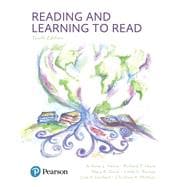Also available with Revel
Revel™ is Pearson’s newest way of delivering our respected content. Fully digital and highly engaging, Revel replaces the textbook and gives students everything they need for the course. Informed by extensive research on how people read, think, and learn, Revel is an interactive learning environment that enables students to read, practice, and study in one continuous experience—for less than the cost of a traditional textbook.
Note: You are purchasing a standalone product; Revel does not come packaged with this content. Students, if interested in purchasing this title with Revel, ask your instructor to confirm the correct package ISBN and Course ID. Instructors, contact your Pearson representative for more information.
If you would like to purchase both the physical text and Revel, search for:
0134996984 / 9780134996981 Revel Reading & Learning to Read --Access Card Package, 10/e
Package consists of:
- 0134447735 / 9780134447735 Reading & Learning to Read, 10e -- Revel Access Card
- 0134894642 / 9780134894645 Reading & Learning to Read, 10e










